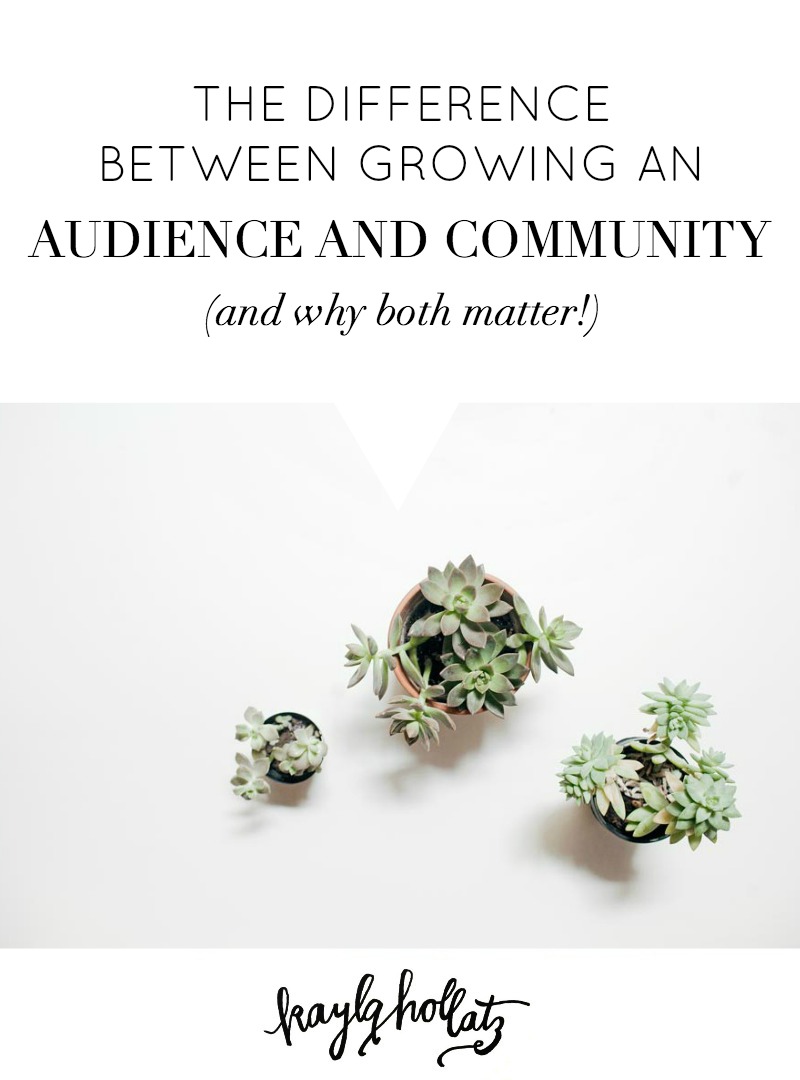The Difference Between Growing an Audience and Community (and Why Both Matter!)
December 7, 2015
Remember that #EpiphanyScope where I promised I’d write a post about the difference between building an audience and community? Well, today I’m delivering.
I often see the terms “audience” and “community” used synonymously, but the process that goes into building both couldn’t be more different.
Although I specialize in helping creative entrepreneurs build sustainable, organic communities, I also know the importance of building an audience that supports your community efforts.
That’s why we are going to cover the difference between audience and community building and a few tips to help you grow both, but let’s start with definitions.
What is an audience?
Your audience is comprised of people who consume your content and even buy your products but with little to no interaction with you.
These people are commonly known as “lurkers”. They come to your website for the goods but don’t take a community action like commenting on your blog post or following up with you on social.
Your audience is often reflected in your pageviews as they can account for a large portion of your traffic. While you’re able to easily track your traffic analytics, it’s hard to determine if those pageviews are coming from your ideal clients with just audience-building techniques. This is one instance where having a community can be extremely beneficial.
What is a community?
Your community is comprised of people who not only regularly consume your content and buy your products but also take action by sharing it and regularly interacting with you. I like to call your community the “feel-good” side of business.
Community breeds die-hard supporters, those who are willing to shout how much they love you from the rooftops. Okay, maybe not exactly, but I’ve always had a flair for the dramatic.
Your community is often reflected in the engagement on your blog, social media, and even in your inbox (hello fun newsletter replies!) The higher the engagement, the more you’re pouring into your people. *high five*
Now that you’re clear on the differences between an audience and a community, how do you go about growing them?
Ways to build your audience:
Designing a stellar user experience
Put yourself in the shoes of a first-time visitor of your website. What catches their eye first? Are all of the visuals on-brand? Is there ample white space and breathing room?
If a visitor can’t navigate your website, they will navigate away from it. A big reason why I migrated from Blogger to Squarespace was to provide a more user-friendly navigation.
Beautiful things happen when you prioritize the user journey. Use your analytics to see which pages your visitors are staying on and which they are leaving from (commonly known as your bounce rate). Analytics don’t paint the whole picture but can reveal some areas for optimization.
Creating a top-level content strategy
What is something a lurker can’t peel their eyes away from? An actionable, I-can’t-believe-this-advice-is-free piece of content.
While one piece of valuable content is great, a full archive of them is even better. This comes from having a consistent content strategy in place that wows your target audience.
Here’s the fun part: creating content so memorable that the lurkers may opt-in for your content upgrade (aka extra juicy piece of content created solely for your mailing list subscribers) or comment on your blog post to tell you how much it helped them. This simple action gives you the opportunity of turning them from an audience member to a community member.
Posting pin-worthy graphics
Pinterest can be one of the best, if not the best social platform to grow your traffic. It’s where many lurkers go to hang out.
Even spending as little as 15 minutes a day pinning new content from your blog and other relevant sources can yield great results. The first step to upping your Pinterest game is by creating images that are:
- Branded (includes your brand’s fonts, color palette, and logo)
- Vertical
- Fitting your audience’s aesthetic
- Clean and minimal
While Pinterest may not be built for community building, it can raise your brand awareness in a big way. This will help your brand become memorable, both visually and through your written, audio, or video content.
Ways to build your community:
Showing an interest in what your community members do
I cannot stress the importance of this step in community building. Nothing makes a person feel more fuzzy and warm inside than someone taking an interest in getting to know them. The more genuine the action is, the more genuine the reaction is.
You may be thinking it’s impossible to reach out to each and every one of your readers. I hear you. Let’s try a super simple weekly activity to help you get in the habit of making these one-on-one connections.
To start, look through your new followers each week and choose 5-10. Carve out 30 minutes to visit each of their websites to learn more about what they do.
Then spend another 30 minutes reaching out to them on your platform of choice. I’d suggest Twitter or Instagram because of its quick but effective nature.
Don’t forget to add a personalized detail! We’ve all gotten the “hey, love your blog” comments but a comment that says “I really enjoyed your post on X and it helped me do Y so I’m looking forward to more content from you” is much more powerful.
Taking just an hour a week to do this can help you feel more connected to your community members and reveal more about your target audience. The person could even be a business bestie in the making. It’s all about showing you care.
Replying to comments, tweets, and emails
Never underestimate the power of one-on-one conversations. When your community members write you a comment, tweet, or email, you should reply back. You’re never too big to talk to your people.
If you’ve ever talked yourself out of replying back to your community because it takes too much time, remember that they understand when it’s not instantaneous. Receiving a reply a few days later is always better than radio silence.
Consistently showing up on social media
Social media is often the place where readers go to reach out to you. These are people who are inviting you into their feed so it’s important to show up and provide value on a daily basis.
A regular schedule shows consistency. *mic drop*
Showing up on social may look different depending on your brand. Maybe you’ll host regular office hours in Periscope where your community members can join you live and ask you questions on the spot. Maybe hosting a weekly Twitter chat is more your thing.
Whatever the platform may be, you’re consistently making yourself available for your community which is a huge deal. This may also be the step where some of your audience members become full-fledged community members.
Sharing their relevant content on social
Who doesn’t like to see their content has been given a shout out on social? It’s an awesome feeling, but social is a two-way street.
When someone in your community shares your content:
- First, say thank you like our momma’s taught us to do.
- Then visit their website to see what they do and who they help.
- If relevant, check out their blog and read a few posts to find your favorite.
- Finally, share it with your POV (point-of-view) rather than just link dropping.
When you use your influence (yes, you have influence, friends!) to give back, you show how important community is to your brand.



